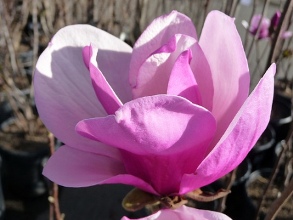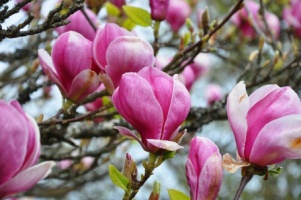Discovered in the Orient, Magnolias were named in honour of the 17th century botanist Pierre Magnol, and have graced western gardens for more than 300 years. The saucer magnolia remains one of the most commonly used magnolias in horticulture, being widely planted in the British Isles, especially in the south of England; and the east and west coasts of The United States.
All winter large green, fuzzy flower buds are carried at the tips of brittle branches, shimmering in the weak sunshine, and once they open, the effect of the blooms against the light grey bark is quite spectacular, taking one's breath away! The flowers are fragrant and usually white, flushed with purple on the outside, but there are many colour variations, from pure white to cream and shades of pink and purple, and if you're lucky, a few additional flowers may bloom sporadically in summer. Fruits are often absent on this hybrid but may appear in late summer, releasing individual, red coated seeds suspended on slender threads.
New leaves are reddish bronze, maturing to large oval, shiny, dark green leaves, turning yellow before dropping again in autumn. The saucer magnolia is typically a small, multi-stemmed tree or large shrub whose growth is upright when young, developing a spreading, rounded crown with maturity. Magnolias are valued for their longevity, and the saucer magnolia grows +-5 to 7.5m tall with a spread of +-3 to 5m. Growth is fairly quick at first then slows down considerably as the tree reaches about 20 years of age.
 Magnolia soulangeana. Picture courtesy Peter RichardsonThe family Magnoliaceae is widely distributed in temperate and tropical Asia, from the Himalayas to Japan, and southwest through Malaysia and New Guinea. East and south-east Asia is its main distribution centre with approximately two thirds of the species. The remainder of the family is spread across the Americas with temperate species extending into southern Canada, and a few tropical species extending into Brazil and the West Indies.
Magnolia soulangeana. Picture courtesy Peter RichardsonThe family Magnoliaceae is widely distributed in temperate and tropical Asia, from the Himalayas to Japan, and southwest through Malaysia and New Guinea. East and south-east Asia is its main distribution centre with approximately two thirds of the species. The remainder of the family is spread across the Americas with temperate species extending into southern Canada, and a few tropical species extending into Brazil and the West Indies.
Today we know that the Magnolia is a very ancient genus which evolved even before bees appeared, because fossilized magnolia flowers, along with their beetles, were discovered in rocks dating around 100 million years old! Due to its great age, this family of plants has survived major geologic events such as ice ages, continental drift and mountain formation, causing its distribution to become fragmented, isolating some species while keeping others in close proximity.
These plants can be found growing in dense woodlands and forests on moist, humus-rich soils; and although they occur mainly in tropical and subtropical climates, many varieties are quite hardy. They are represented by over 240 species and hundreds of varieties, both deciduous and evergreen, all of which are also highly diverse in their growth habit, ranging from tall trees to various sized shrubs.
The saucer magnolia is a magnificent garden hybrid which was initially bred from (M. denudata x M. liliiflora) by French plantsman Etienne Soulange-Bodin in the early 1800s. Plant breeders in many countries continue to develop this magnolia, and over a hundred named cultivars are now known, so you are sure to find your perfect one!
 Picture courtesy Green Acres Nursery CaliforniaIn the Garden:
Picture courtesy Green Acres Nursery CaliforniaIn the Garden:
The saucer magnolia will start blooming after 4 to 5 years and can be pruned into a large shrub or small tree. Plant it where its great beauty can be enjoyed - it makes a wonderful specimen flowering tree and is invaluable in a mixed tree and shrub border. If planted close to a walkway or patio it can be pruned up to allow for pedestrian clearance, but if left to take on its natural shape the branches will droop right down to the ground, making an incredible display.
If space is limited in your garden and you simply have to have a magnolia, consider growing one in a large container, the saucer magnolia does quite well in pots.
Magnolias are also well-suited to espalier. Espalier is the practice of controlling woody plant growth by tying the branches to a wooden or wire frame so that they grow into a flat plane; frequently in formal patterns, against a structure such as a wall, fence, or trellis.
Espalier, trained into flat two-dimensional forms, are ideal not only for decorative purposes, but also for gardens in which space is limited. Also, in cold regions, if trained against a sunny wall or fence it will afford protection and warmth during the cold winter months. Despite this practice, reports of damage to the foundations of buildings or walls, is uncommon.
Initially the young shoots are bent down and tied very gently to only about 45 degrees, or they may break. During the growing season they can be encouraged into the more horizontal position required to train them along the frame. Prune regularly to remove any shoots growing towards the wall, and shorten outward-growing ones to one or two leaves. If these outward-growing shoots have flower buds, pruning can be delayed until immediately after flowering.
 Picture courtesy Lotus Johnston - see her flickr pageCultivation/Propagation:
Picture courtesy Lotus Johnston - see her flickr pageCultivation/Propagation:
Magnolias are easy to grow and relatively pest free, and once established will need the minimum of attention. The saucer magnolia grows best in cool areas with good rainfall and mild winters. The plant itself is fully hardy, but the flowers are tender and often reduced to sad rags by late frosts and freezing winter winds. In cold regions position the plant in a sheltered part of the garden where it will not be exposed to very early morning sunshine in the winter, as this will burn the frosted buds and flowers - a position with early shade and sun later in the day is best. Thick mulch around the roots will help prevent them from freezing. The saucer magnolia also has moderate salt spray tolerance, but it is best to have more protection, such as a fence or building, as an additional barrier behind the first row of plantings or the first dunes.
The saucer magnolia can be grown in full sun or semi-shade, but requires adequate sun to flower well. In sub-tropical and hot zones it is best to plant it in a cool spot where it will be sheltered from the fierce midday sun and hot winds. In the winter rainfall regions it must be watered regularly throughout summer, and planted in a wind protected spot. In these regions it is also essential that the soil has excellent drainage. Magnolias are not suitable for the very dry parts of the country, and in all regions it is most important to water regularly during dry spells. Mulching the roots in summer will help to retain moisture and keep them cool.
Because of its shallow root system the magnolia is sensitive to root disturbance, and is also very fussy about its depth of planting. Never plant it deeper than it is growing in its nursery bag, and keep mulch well away from the trunk. Once established magnolias are not easily transplanted, so ensure you plant it in the correct position.
It is important to prepare the planting holes well because specimens grown in heavy, compacted, or poorly drained soil will appear stunted. The saucer magnolia thrives in a slightly acidic, loamy, well-drained soil which is rich in organic matter and which retains moisture throughout the year. However, it is more tolerant of alkaline soils than other magnolias. In alkaline soils, prepare the planting holes well, adding lots of acid compost and other organic material. To encourage faster growth, feed with a balanced fertiliser during the growing season.
If you wish to train your plant, do this when it is still young, because older plants do not like to be pruned, and large wounds may not close well.
Cuttings, layering, and grafting are the preferred methods of propagation. After a layered branch has rooted, it can be cut from the parent stock and survive on its own.
Problems, Pests & Diseases:
The saucer magnolia suffers from no serious insect or disease problems but is susceptible to sooty mould associated with scale; and the limbs may break in strong winds and during heavy storms.
Warning:
Happily the saucer magnolia is listed as non-toxic, but it is always sensible to keep pets and small children from chewing on plants.



